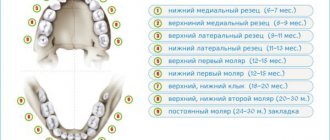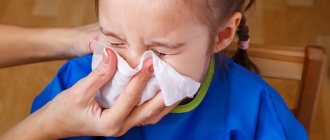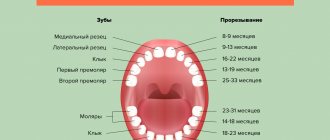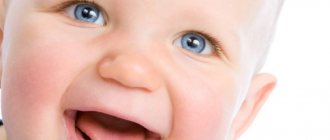From this article you will learn:
- when the first teeth appear
- sequence of teething in children,
- terms for baby and permanent teeth (scheme),
- reasons for delayed eruption.
The article was written by a dentist with more than 19 years of experience.
Teething in children is the process of gradual appearance of tooth crowns above the surface of the gums. Teeth are considered fully erupted when their chewing surface begins to contact the antagonist teeth of the opposite jaw, and the gums cover the crowns of the teeth only in the area of their neck. Eruption always occurs in 2 stages. First, temporary milk teeth erupt, and only when the jaws reach the desired size do permanent teeth appear in place of the fallen milk teeth.
The eruption of primary teeth in a child usually begins at 5-6 months and will continue for up to 24-30 months, and during this time a total of 20 primary teeth will appear. The process of replacing baby teeth with permanent ones begins at the age of 6 years. The eruption of permanent teeth occurs up to 14 years of age inclusive - with the exception of wisdom teeth, which usually appear after 18 years of age. There is a strict sequence of teething in children, which you can see in the diagrams below.
Gums during teething: photo
Traditional symptoms of the eruption of baby teeth are swelling and redness of the gums, increased salivation and drooling, in addition, the child becomes restless and sleeps poorly. Sometimes indigestion and a slight increase in temperature may occur. In some cases, 2-3 weeks before eruption, a lump filled with clear or bluish liquid may appear on the gum, which does not indicate inflammation or any pathology (Fig. 2).
→ How to relieve teething symptoms in a child
Teething in infants
Baby teeth begin to appear in the first year of life. Typically, the harbingers of such an event are a number of symptoms:
- excessive salivation, which can lead to hoarseness and coughing, a rash in the chin and mouth;
- itching of the gums, which the baby tries to relieve by chewing everything that comes to hand, including the hands themselves;
- soreness, swelling and redness of the gums;
- decreased or lack of appetite, refusal to eat;
- increased excitability;
- sleep disturbance;
- changes in stool;
- runny nose;
- temperature increase.
Teething can sometimes be accompanied by nausea, vomiting or diarrhea, but do not neglect a pediatric examination, the reasons for this may be completely different.
The symptoms of teething have much in common with infectious diseases, so experts do not recommend self-medication; in any case, the child must be shown to a pediatrician. Only the experienced eye of a doctor can determine the full picture of the child’s condition.
When do baby teeth appear?
Teething is not a chaotic process, it occurs in a certain order. Teeth appear in pairs, for example, 2 incisors, 2 canines, 2 first molars, etc. Temporary teeth begin to appear closer to 6-7 months of life, but if teeth are in no hurry to appear, then there is no need to worry, the first tooth may appear when the baby is already 1 year old - and this is quite normal.
The order of teething in children: diagram
In the vast majority of children, the first temporary tooth appears on the lower jaw.
The timing and speed of teeth appearance can be influenced by heredity, as was the case with parents in childhood. This process can also be affected by nutrition, water, climate, diseases and even care habits.
Delayed eruption may also have a connection with the child’s growth retardation or retardation in his overall development. This can happen if the baby has, for example, rickets (lack of vitamin D) or edentia (lack of tooth buds).
Cute baby photo frame with poems about the first tooth
Cute children's photo frame in scrapbook style with a wonderful poem.
Now I can eat even an oak tree - The first tooth has appeared! I have no strength to resist, I really want to bite. And I chew on everything: A doll, a ball and a bed, Even a toe, If I come across it anywhere. They say I'm funny with him. They are waiting for the second one to appear. I will eat for five, When there are many of them.
Select a photo on your computer
Using the buttons you can change the position, size, and angle of the thumbnail. The "Color" button will allow you to create a black and white thumbnail image. Clicking on the “Return original image” link cancels all transformations of the thumbnail.
Download a high-quality image for printing on a printer or photo studio
,
print size 30.5 x 20.3 cm
, without site logo, with a resolution of 3602 x 2398 pixels, 300 dpi
How to download a high-quality PREMIUM image:
1.
Click on the “Payment via: Interkassa” button. The payment service will open in a new tab. Choose a convenient payment method and follow the instructions.
2.
To receive a password, immediately after making the payment, on the payment page, click the
“Go to the site”
or use the
“I paid and want to receive a password”
on this page. The password will be sent to you by e-mail.
3.
With one password you can download
five PREMIUM images
within 12 months.
4.
Enter your password and download
a PREMIUM image without the site logo, print size 30.5 x 20.3 cm
, with a resolution of 3602 x 2398 pixels, 300 dpi
5.
If you have
questions
, please ask them using the contact form located on the
“Contact”
.
Download free image for viewing on a monitor screen, print size 5.1 x 3.4 cm, with the site logo, with a resolution of 600 x 399 pixels, 300 dpi
Arrange your favorite photos in an interesting way!
Your favorite photo will seem even more attractive if you put it in a frame. Photo frames, for every day, for events, holidays, seasons, for lovers, for family and friends, women's, men's, children's, school, simple, different frames will easily transform any photo in just a couple of minutes. Sometimes it’s enough to insert a photo into a frame and you’ll get your own unique postcard. Such an original card can be given not only in honor of the holiday. One small postcard can sometimes replace hundreds of words. With its help, you can easily convey your feelings or warm wishes to your loved ones. You can say, “Thank you,” “I miss you,” “I’m sorry,” without saying a word. You can simply express your concern, or share your mood with friends...
Eruption of molars in children
The eruption of permanent teeth is another unpleasant process that usually begins in children at the age of 6-7. The timing of their appearance is vague and varies within 2 years, that is, the appearance of teeth in the period of 5-7 years is considered the norm. The symptoms of teething in children are similar to the appearance of teeth in infancy:
- heat;
- refusal to eat, lack of appetite;
- changes in stool consistency;
- swollen and sore gums;
- excessive salivation;
- nervous state, sleep disturbance;
- the appearance of gaps between temporary teeth;
- looseness of baby teeth.
Fortunately, such symptoms do not always occur or are not as severe as in infancy. As the jaw grows, the primary teeth gradually move away from each other, and the appearance of the molars occurs more easily.
When to see a doctor?
If any of the above symptoms appear, it is better to call a pediatrician at home or come to an appointment at the clinic and show the child to a doctor. He will conduct a study and rule out or confirm another cause of such negative symptoms, which may or may not be related to teeth.
However, there are more dangerous symptoms for which a pediatrician cannot be avoided. In particular, doctors include several main symptoms as dangerous signs that should never be ignored:
- The physiological process is accompanied by severe coughing attacks. In particular, excessive salivation and a large amount of saliva will flow down the throat and provoke coughing attacks in the child. The baby's cough reflex attacks will intensify when lying down - it will become wet and intrusive, and will interfere with sleep and eating. Parents may suspect an infectious lesion of the body - a cold, and in this case its attacks will last more than 2-3 days. May be accompanied by shortness of breath and difficulty breathing - this may indicate inflammation of the upper respiratory tract.
- Copious discharge from the nasal passages - normally it should be clean and transparent, like water. Such symptoms most often go away after 2-3 days - just rinse the nasal passages with a salt solution. If an infectious process develops, the nasal discharge will be quite abundant, its color will become yellowish or greenish, and last more than 4 days.
- Excessive saliva production in a baby can provoke stool upset - when it gets into the digestive tract, it accelerates intestinal motility and provokes diarrhea 2-3 times a day. When an infectious process occurs in the body, diarrhea will bother the child more than 3 times a day, interspersed with mucus and blood. Thus, inclusions in the stool of blood can indicate intestinal infections and disorders of the digestive system.
In such cases, it is worth taking the child to the dentist. It is also worth taking your baby to a specialist in case of not only prolonged diarrhea and the threat of dehydration, but also in case of the exact opposite phenomenon - constipation. If a child’s immunity is weakened, during teething he may develop diseases of the oral cavity.
Most often the following pathologies show themselves negatively:
- Thrush - it is provoked by a fungus from the genus Candida and is classified as a fungal disease that develops against a background of weakened immunity. In this case, the child’s gums and tongue will be covered with a whitish coating , itching, decreased appetite, and increased pain will appear.
- The development of stomatitis in a child - ulcers and wounds can cover the oral cavity , causing the baby a lot of anxiety.
In such cases, it is worth showing the child to a pediatrician - this will eliminate any negative consequences and give advice on how to alleviate the baby’s general condition at this stage of its development. This will help both the baby and the parents, and all negative symptoms can be overcome easily and without any special difficulties.
Molars also erupt approximately in this order:
- 6-8 years: central incisors and molars.
- 8-9 years: lateral incisors above and below.
- 9-10 years: lower canines;
- 11-12 years: upper canines.
- 10-12 years: first and second premolars (top and bottom).
- 11-13 years: second molars – large chewing teeth.
The very last wisdom teeth to emerge. Third molars appear in adolescents between the ages of 17 and 21. However, it is worth noting that these terms are provisional. There are cases where wisdom teeth appeared by the age of 26, but if by 28 they still have not erupted, then there is no point in waiting for them.
When do babies' first teeth start to come out?
The table shows at what age children’s first teeth erupt and in what order ( to understand the table, please look at the photo below ):
| Baby's age | Place of cutting |
| 6-7 months | Lower central incisors |
| 8-9 months | Upper central incisors |
| 9-11 months | Upper lateral incisors |
| 11-13 months | Lower lateral incisors |
| 12-15 months | Upper small molars (molars) |
| 12-15 months | Lower small molars (molars) |
| 16-18 months | Upper canines |
| 18-20 months | Lower canines |
| 24-30 months | Lower large molars (molars) |
| 24-30 months | Upper large molars (molars) |
As doctors note, babies’ first teeth begin to emerge at 6-9 months. If the time frame is somewhat delayed, parents should take the child to a pediatrician and dentist. If we talk about the fact that the timing of the appearance of teeth may be atypical, this may indicate certain disorders in the baby’s body:
- if teeth come in 2 months later than normal, this may indicate an infectious disease in the body, a malfunction in metabolic processes and the functioning of the digestive tract;
- when teeth come in 2 months ahead of schedule - this may indicate a malfunction of the endocrine system;
- If the first teeth in infants are cut incorrectly, outside the gum, this indicates an incorrect position of the tooth axis. In this case, surgeons will have to intervene, using special bales and prostheses to guide it correctly.
If there are certain suspicions of pathology or its detection, it is best to show the child to a pediatrician and pediatric dentist.
Mechanical methods (relevant for infants):
- Give your baby all sorts of teething aids. Rubber “rodent helpers” can be bought at any children's store or pharmacy; they are filled with gel or liquid specifically for a cooling effect. However, teethers must sometimes be put in the refrigerator and then given to the child to chew on.
- Bottles and pacifiers also satisfy your baby's chewing needs. These attributes should be made of high-quality silicone or latex, preferably in an orthodontic form, so as not to disturb the child’s bite.
- Finger brushes, which are placed on an adult’s finger for massage in the baby’s oral cavity. In addition, by the strength of your bite you can determine how soon the first tooth will appear.
- Massage the gums with a damp gauze pad. A gauze swab must be moistened in cold but boiled water and massaged into the baby’s mouth, this will help relieve itching and cleanse the child of germs.
Congratulations on your first tooth
First tooth?
Congratulations! This is cool, what can I say, the baby can bite you fully with a smile. Let your teeth grow quickly, let them not bring pain, let every tooth be strong and healthy.
At night, when sleep descended, magic happened, the first tooth appeared, you should meet it quickly!
You can eat whatever you want, and bite your parents, and charm everyone in the world with an excellent smile!
I congratulate the beautiful baby on his first tooth and wish that all subsequent teeth are strong and healthy, and that the tooth fairy always arrives on time and not empty-handed.
The first tooth has appeared, Oh, what a beauty! Congratulations to mom and dad, There is joy and bustle in the house.
Let him now gnaw the carrot. This bunny is groovy. After all, teeth are of more use. Be healthy always, dear!
Happy first tooth, hooray! This is such a miracle, this is such joy, Yesterday was not yet - And today it sparkles.
Grow up quickly, baby, If you have teeth, everyone will be happy, After all, you still have thirty-one left to grow!
And here is your first tooth, we have been waiting for it very, very much! You are our golden child And we laugh with joy!
Now we are all looking forward to Zubika’s “relatives”, To expand your menu And develop your skills!
An important event - your first tooth, we congratulate you, our dear baby.
We wish that teeth cut through without pain, Nipples and pacifiers quickly, so that they do not tear.
Soon, soon you will bite and bite, your first tooth For the whole family - happiness.
The first tooth is a miracle! Congratulations, what can I say! All things will be used to scratch your gums.
After him, the second will break through, The third will grow up, Let the little one laugh wider, To show all his teeth!
Everyone had been waiting for him for so long, they even bought a brush, and today, suddenly, with delight, everyone sees the first tooth clearly.
Dad is happy and mom is happy, we finally got a miracle! You need to bite them urgently, so that they don’t laugh too much!
The first tooth, finally, I will congratulate you, I wish happiness, joy, health to the Bunny with his tooth.
Let your child make you happy, let your teeth grow quickly, let them bring no more discomfort to your baby.
I hasten to congratulate you on your child’s first tooth. An unexpected “bite” is now waiting, Just don’t shout loudly!
Let the tooth grow faster, And the second one will appear right away, So that the baby will disarm you with his smile!
Medicinal methods (relevant for children of any age)
Of course, it is difficult to cope during such a period without effective drugs, because... Mechanical methods are not always able to relieve pain and are even more powerless in the face of heat. Today, the pharmaceutical market offers a variety of gels, syrups, tablets, ointments and other products for internal and external use. Let's look at the main categories and most popular drugs:
- Gels, drops and ointments for topical use that relieve inflammation, destroy pathogenic microorganisms and instantly relieve gum pain - Cholisal, Dentol Baby, Dentinox, Kamistad Baby, Baby Doctor first teeth, Kalgel, Solcoseryl.
- Antipyretic, analgesic and anti-inflammatory drugs for internal use - Dantinorm baby (homeopathy), Nurofen syrup (other children's syrups with ibuprofen), Efferalgan syrup (other children's syrups with paracetamol), Dentokind tablets (homeopathy), Riabal syrup.
- Antipyretic, analgesic and anti-inflammatory drugs for rectal use - Efferalgan suppositories (other suppositories with paracetamol), Nurofen suppositories (other children's suppositories with ibuprofen), Viburkol suppositories.
Something worth knowing!
Sometimes, a few weeks after the appearance of a permanent or baby tooth, a bluish lump may appear in that place. This is not a pathological phenomenon, it is not accompanied by inflammation and does not pose a danger to the child. This is just an accumulation of bloody fluid that can be released with a light incision if it is too large and bothers the baby.
If there are white and brown spots, stripes, pits or depressions on the first milk teeth, then this is considered a violation. Enamel hypoplasia occurs due to pathology during fetal development in the womb. This disorder appears in children whose mother suffered from constant toxicosis, severe stress, herpes infection, kidney disease, rubella, toxoplasmosis, high fever due to acute respiratory infections and pneumonia.










